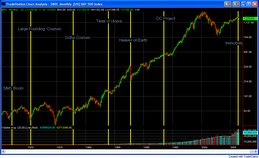A recent IA experiment press release states the "advanced econometric models" show a 3/10,000 chance for normal occurance of recent market increases since the start of IA. Thus the so-called rarity of the event opens the door for claims of some special new effect.
Lets actually look at the data.
The current IA experiment has run 17 full weeks, and the S&P 500 has risen 12.9% in that period. Good show.
But what is the naturally occurring frequency of a 12.9% or better gain in any 17 weeks period. Going back to 1960, it has occurred on average 4.98 times / year. That is, for any given start week, there is a about a 10% (4.98/52) chance, historically over almost 50 years, that there will be a 12.9% or better gain in the S&P500.
And if you allow 20 weeks to realize the same 12.9% gains, that is, same returns, albeit gained slightly more slowly, it has occured on average 7.1 times per year. About a 15% probability that any week will be the start of a 12.9+ gain over the next 20 weeks.
And there is a 20% probability that you will get a 10% or better return on the S&P 500 within 20 weeks.
For the IA experiement claim the current rise in the financial markets since July 21, 2006, the start of the IA experiment, is a very rare event, of the magnitude of 3/10,000 probability is preposterous, and indicative of very naive or slanted research.
12 times there has been double or greater that approximate 13% gain, that is greater or equal to 26% gain in 17 weeks periods -- going back to 1960. It has occurred on average once every four years.
So if the IA produced that rate of growth, they might begin to be able to claim something fairly unique is occuring. Or best, if the S&P 500 yielded a 35% gain in 17 weeks -- which has never occurred in the period since 1960.
If the IA feels the ME is causing the current stock gains, then they need to explain what was the cause of the other 220 or so such rises in the market since 1960 and why such factors are not involved in this recent run-up.
And address why the ME has not caused gains to exceed all others 17 week run-ups -- that is why it has not pushed the market ahead at a 35% clip in 17 weeks.
Looking ahead, the 1750 YF number is just about to be met. So the ME is just beginning, per "theory". What would be unique market events to judge the ramped up, reved-up ME?
A 45% gain over 26 weeks, nor a 60% gain sustained over 52 weeks has ever been achieved by the S&P 500, looking back to 1960. Those are good benchmarks to keep in mind for IA to achieve if the ME is having an effect on markets. It still doesn't establish causality, but would give reason to pursue detailed statistical studies to investigate causality.
So taking the almost 13% gain in 17 weeks as a base, we just need to see an additional 32% gain in the S&P 500 over 9 weeks (from this past monday), and/or a 47% gain over the next 35 weeks to demonstrate a clearly unique event. Until then, or some market movements approaching such, the IA ME PR pronouncements on financial markets will sound a bit hollow.
Subscribe to:
Post Comments (Atom)


No comments:
Post a Comment